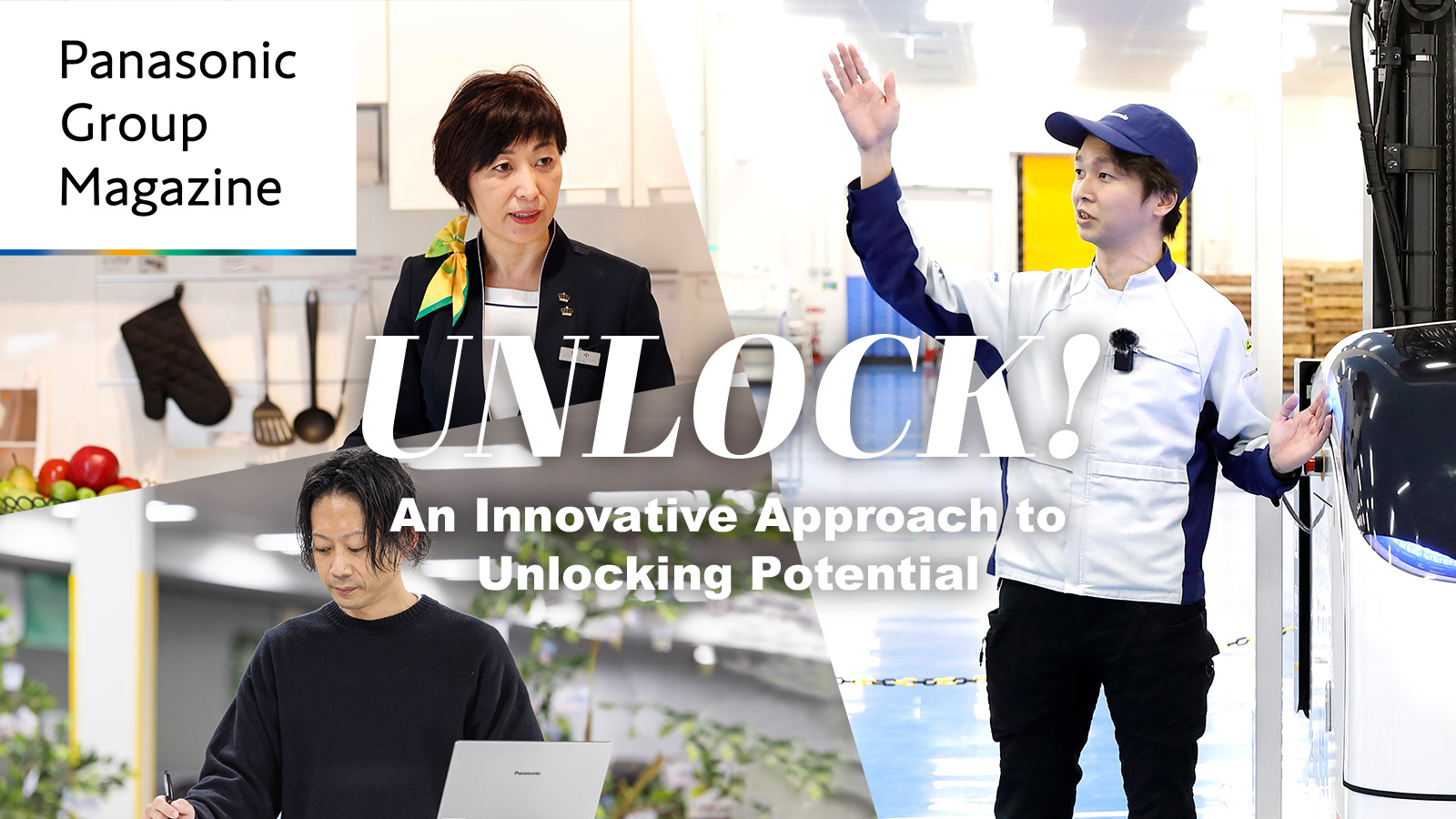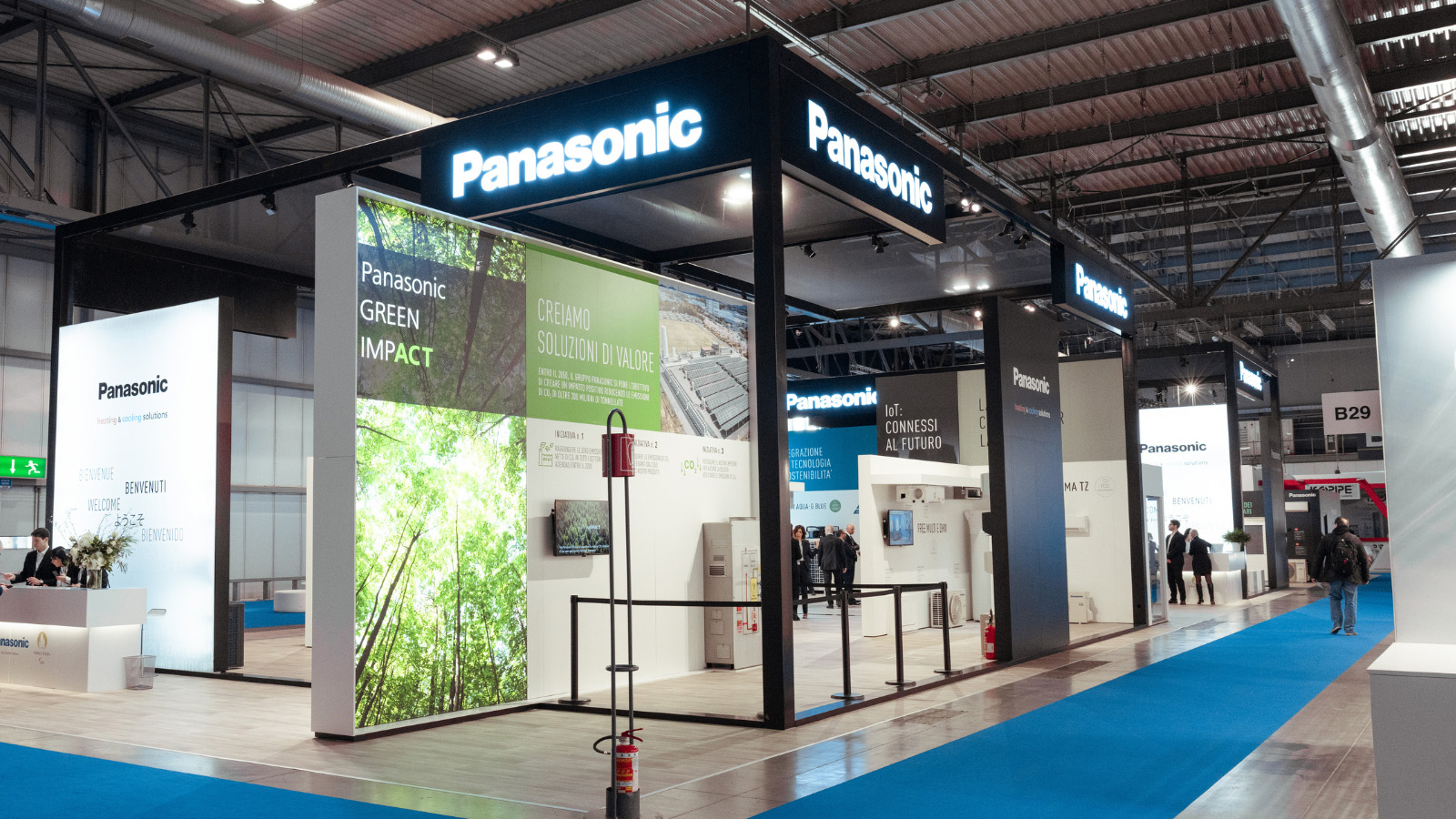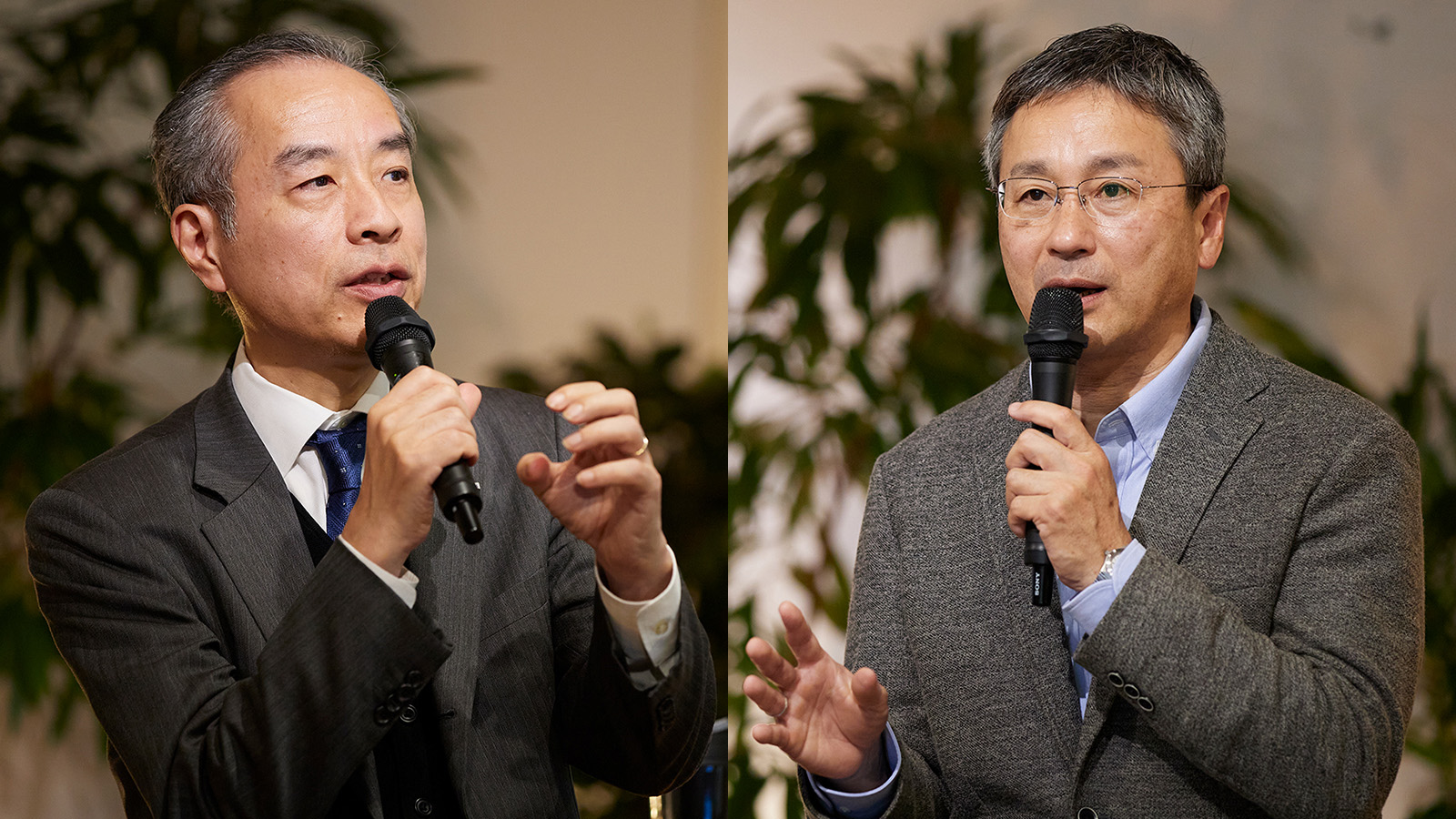May 11, 2012
Press Release
Panasonic Announces Annual Business Policy
Osaka, Japan, May 11, 2012 - President Fumio Ohtsubo of Panasonic Corporation (NYSE : PC/TSE:6752,"Panasonic") today announced its business policy for the fiscal year ending March 2013 (fiscal 2013) at the company's business policy meeting. Addressing before an audience of Panasonic Group employees, he summarized the group's progress made in the previous business year and outlined its goals for fiscal 2013. The following is a summary of his presentation.
1. Achievements
(1) Vision toward 100th Anniversary and Implementation of GT12: Panasonic embarked on the GT12 in 2010 as the first step to achieve its vision of becoming the "No. 1 Green Innovation Company in the Electronics Industry" by the 100th anniversary of its founding. The vision aims to realize a sustainable and better living by integrating the company's contribution to the environmental protection and business growth. The midterm business plan calls for paradigm shifts in its business from existing to new fields, from Japan-oriented to globally-oriented and from individual product-oriented to solutions and systems business-oriented, with the aim to make a company filled with significant growth potential.
(2) Integration and Reorganization following Acquisition of PEW and SANYO: After turning Panasonic Electric Works Co.,Ltd.(PEW) and SANYO Electric Co.,Ltd.(SANYO) into wholly-owned subsidiaries, Panasonic implemented a group-wide reorganization in January 2012. Based on business models developed from customers' perspectives, the company reorganized its structure by consolidating 14 internal companies, called "business domain," under five segments into nine business domain companies under three business fields. Through the reorganization, Panasonic has established the structure enabling the company to have direct contact with customers globally. In the consumer business field, marketing divisions were united into one to strengthen its frontline functions globally. The reform has also introduced a new structure and system enabling to demonstrate its collective strength across the entire group companies and promote comprehensive solutions. Panasonic has also built up a framework to maximize synergies brought about by the acquisitions of PEW and SANYO, primarily in the environment and energy related businesses. At the same time, Panasonic has pushed ahead with eliminating overlapping businesses and streamlining operations.
(3) Large-scale Structural Reform: In a continuing tough business environment - with the global economic slowdown, the appreciation of the yen and the flooding in Thailand - Panasonic carried out restructuring of unprofitable businesses to reduce fixed costs, incurring goodwill impairment loss for SANYO businesses and streamlining the entire group. Overall, the company booked restructuring costs of 767.1 billion yen in fiscal 2012, ended March 2012, to remove all obstacles for the future profitability of the company.
(4) Summary: Panasonic fell short of the numerical management goals set in the GT12 and was forced to give up them. However, the company has built the structure and foundation towards achieving its vision of the Green Innovation Company. Taking measures to overcome challenges, the company will start afresh to move forward pursuing growth with profitability.
2-1. Initiatives for Fiscal 2013 (Positioning and Business Targets)
In fiscal 2013, Panasonic has to show ever greater performance. The company will strive to achieve a V-shaped recovery, getting the most out of the new organization. Panasonic has set the business targets for fiscal 2013 as follows:
| Sales | 8,100.0 billion yen |
103% |
|---|---|---|
| Operating Profit(%) | 260.0 billion yen (3.2%) |
+216.3 billion yen |
| Net Income attributable to Panasonic Corporation(%) | 50.0 billion yen (0.6%) |
+822.2 billion yen |
| ROE | 2.6% |
— |
| Free Cash Flow | 100.0 billion yen |
+439.9 billion yen |
| CO2 Emission Reduction | 41.00 million tons (compared to FY2006) |
+0.63 million tons |
2-2. Initiatives for Fiscal 2013 (Basic Policy and Measures)
(1) Focus on Profitability
1) Restructure Unprofitable Business: Panasonic will reap the fruit of the large-scale structural reform of the TV business carried out in the last fiscal year. In the TV set business, the company aims to steer it into the black through thorough cost cuts by reducing unprofitable models and reviewing cost structure. In the panel business, Panasonic aims at significant improvements in profitability by reducing fixed cost and shifting focus to non-TV products such as medical equipment, tablet PCs and electronic whiteboards.
2) Increase Profitability in Growing Businesses:
Solar Business: Targeting the residential sector, where benefits of the high-efficient HIT solar panels can be fully utilized, Panasonic will make the fullest use of the group's sales channels in Japan to significantly increase sales. Panasonic has set sales target of 450 megawatts or more, 1.6 times the previous year, to capture top market share in the Japanese market. A new solar manufacturing facility in Malaysia, which is slated to become operational in December 2012, will significantly bolster Panasonic's cost competitiveness and supply capacity. Panasonic started to propose new values with such devices as energy creation-storage coordination systems by linking devices and equipment in various ways. Panasonic expects domestic sales of 110.0 billion yen from the solar-related systems as a whole, including power conditioners and storage batteries, and will maintain high growth with profitability.
Lithium-ion Battery Business: In the consumer-use battery business, Panasonic will focus on the following three points: boosting cost competitiveness by increasing materials procurement in China and Korea; making high-capacity batteries using the company's own technology; and speeding up development and customer support. Then, the company will reinforce its offerings in such fast-growing markets as ultrabook PCs and smartphones that require slim and high-capacity batteries. In the automotive battery business, the company will take a multi-directional approach in addressing eco cars. Capitalizing on its advantage as a leading battery manufacturer, Panasonic strives to increase sales of automotive use batteries more than five-fold by maximizing the production capacity and cost competitiveness. The company aims to return both consumer and automotive battery businesses on the profit path this fiscal year.
Appliances Business: Panasonic aims to achieve a 20% increase in overseas sales in fiscal 2013 over the previous business year, seeking for growth opportunities across its products and the globe. To attain this goal, the company will create locally-oriented products based on studies of its lifestyle research centers. Launching of its energy-efficient Eco Navi appliances in the global market and offering of small appliance as groups of products are also part of the company's plans to strengthen and expand the appliances business as a stable profit source.
3) Creating Strong B to B Business
Panasonic will create solutions-type business models. A good example is aircraft in-flight entertainment systems business. The in-flight AV system supplier stays connected with its customers and keeps delivering high values in services and products.
4) Establish Comprehensive Business Models
The comprehensive solutions business creates and offers new values across business domain companies at Panasonic. To provide maximum value to its customers, Panasonic will assemble competitive individual products, combine and link them into a system and provide repair and maintenance service. Panasonic will make a company-wide effort to promote its "100 Arrows" project, which aims to create 100 business models in the comprehensive solutions business. In fiscal 2013, Panasonic plans to develop 50 arrows including those already in the start-up stage, aiming to generate sales of 170.0 billion yen or more.
5) Strengthen Business Structure: Panasonic will enforce cost cuts across the group, including the head office, to improve profit structure. The efforts will include cost cuts through optimization of procurement activity on a global scale, maximization of synergies and reduction of fixed costs as a group-wide emergency management action. With these cost cutting efforts, Panasonic aims to lower the break-even point by 7% in fiscal 2013, strengthening the business structure to the level of fiscal 2011.
(2) Strengthen Products
1) Pursue Locally-oriented Products: In home appliances, Panasonic will combine its environmental core technology with lifestyle research and consecutively launch high-volume-segment products with No.1 eco performance, such as air conditioners, refrigerators and washing machines, in China and other emerging economies. In the TV business, Panasonic will propose products unique to each market by combining its VIERA TV's smart functions and local content. Starting in India, the company will introduce locally-oriented products in other countries.
2) Both Engineering and Marketing Directly Contact with Customers: Industrial Devices Company, working with the Corporate Device Application Division, will strengthen its ability to understand customers' needs proactively and propose solutions by capturing market needs and trends in a timely manner and actively get itself involved in the early stage of product development such as conceiving and designing processes at customers. The company will take this proactive marketing approach, focusing on rapidly-growing areas, including smartphones and eco cars.
3) Be Competitive by Combining and Linking Products: Panasonic will hone the strengths that make it different from other companies, such as its technologies to link products and ability to offer a variety of product lines. In the Japanese market, Panasonic will introduce from fiscal 2013 a line-up of "smart" home appliances, including a microwave oven that allows users to download a recipe using their smartphones and set the cooking instructions.
(3) Take Initiatives to Change Itself and Make Changes
1) Overcome Challenges: Each and every Panasonic employee is challenged to draw vitality to break down barriers. In the development of large-size air conditioners, for example, Panasonic has built a framework and foundation on which members from the former Panasonic Home Appliances Company and SANYO working hand in hand, crossing the organizational boundaries, to blend their technologies together and create innovative products.
2) Transform with Local Leadership: Panasonic is pushing forward projects aiming for a substantial sales increase in India and Brazil. When implementing these projects and developing new businesses, local companies of Panasonic will take initiatives, leading and involving relevant business domain companies and functions to succeed.
3) Reform Head Office Functions: Panasonic is reforming and simplifying the head office functions as well as rebuilding group-wide management system, aiming to have a small head office focusing on strategy and investment. The company will complete the reform of its head office by the end of fiscal 2013.
(4) Targets and Initiatives of Individual Business Domains
1) Consumer Business Field: Returning to profitability is the top priority for AVC Networks Company. To accomplish, the company will improve the bottom line of the TV business and shift its resources to non-TV and non-commoditized businesses. At the same time, the company will strive to create new pillars to drive business growth for the next generation.
Appliances Company will endeavor to accelerate global growth of its B to C business (finished products). It will also aim to expand its B to B business, such as large-size air conditioners and cold chain. It will also work to increase added values for products and improve cost competitiveness.
Global Consumer Marketing Sector will increase overseas sales, focusing on appliances and emerging economies. Developing major appliances, mirrorless single-lens cameras and small appliances as growth pillars, the sector will strengthen a pull-marketing strategy and actively promote groups of products overseas.
2) Solutions Business Field: Systems & Communications Company will strengthen the integrated network business (security, cloud) and focus its efforts on smartphones in the mobile business. The company will also accelerate global expansion of solutions business.
Eco Solutions Company will increase sales in the environment and energy fields with a focus on LED and solar businesses. The company will also accelerate the shift of resources to expand business overseas. At the same time, it will come up with concrete ideas for the comprehensive solutions business and obtain tangible results.
Healthcare Company will accelerate growth, focusing on businesses having sales channels, and reinforce its marketing capability in the medical and nursing-care fields, utilizing customer contact points.
Manufacturing Solutions Company will develop new businesses and expand into growth markets. It will strengthen its manufacturing capability overseas as well to implement the principle of local production for local consumption.
3) Components & Devices Business Field: Automotive Systems Company will increase profitability in multimedia business and develop new markets. The company will work at creating a business model for the EV-related business. At the same time, it will restructure its BCP (business continuity plan) and improve product quality.
Industrial Devices Company will establish a strong management structure that does not depend on sales performance. The company will focus on strengthening its business in the mobile and environment (vehicles and infrastructure) fields. Efforts will also be made in eliminating losses in unprofitable businesses, including semiconductors and optical pickups.
Returning to profitability is the first priority for Energy Company, which will shift to a profitable management structure. The company will make strategic investments in key businesses such as solar and lithium-ion batteries. It will improve profitability of its basic core businesses, including dry batteries.
3. Towards Green Innovation Company
By the end of 2012, Panasonic will finish laying the foundation, including the group's reorganization, towards fulfilling its goal of becoming the "No. 1 Green Innovation Company in the Electronics Industry" by 2018. In the next three years from 2013 to 2015, the company will reconstruct its profit framework and blaze a path towards the Green Innovation Company. In pursuing the new goals, Panasonic reaffirms that it is the employees who provide the foundation for growth. The company will unify and share with all the employees around the world its personnel development policy as well as personnel system and structure designed for executives. Each and every employee is asked to have an entrepreneurial spirit, mix together with other people, gather the wisdom of all and create something completely new. With the company's management philosophy in mind, Panasonic will head together towards a V-shaped recovery.
About Panasonic
Panasonic Corporation is a worldwide leader in the development and manufacture of electronic products for three business fields, consumer, components & devices, and solutions. Based in Osaka, Japan, the company recorded consolidated net sales of 7.85 trillion yen for the year ended March 31, 2012. It aims to become the No. 1 Green Innovation Company in the Electronics Industry by the 100th year of its founding in 2018.The company's shares are listed on the Tokyo, Osaka, Nagoya and New York (NYSE:PC) stock exchanges. For more information on the company and the Panasonic brand, visit the company's website athttp://panasonic.net/
Disclaimer Regarding Forward-Looking Statements
This press release includes forward-looking statements (within the meaning of Section 27A of the U.S. Securities Act of 1933 and Section 21E of the U.S. Securities Exchange Act of 1934) about Panasonic and its Group companies (the Panasonic Group). To the extent that statements in this press release do not relate to historical or current facts, they constitute forward-looking statements. These forward-looking statements are based on the current assumptions and beliefs of the Panasonic Group in light of the information currently available to it, and involve known and unknown risks, uncertainties and other factors. Such risks, uncertainties and other factors may cause the Panasonic Group's actual results, performance, achievements or financial position to be materially different from any future results, performance, achievements or financial position expressed or implied by these forward-looking statements. Panasonic undertakes no obligation to publicly update any forward-looking statements after the date of this press release. Investors are advised to consult any further disclosures by Panasonic in its subsequent filings with the U.S. Securities and Exchange Commission pursuant to the U.S. Securities Exchange Act of 1934 and its other filings.
The risks, uncertainties and other factors referred to above include, but are not limited to, economic conditions, particularly consumer spending and corporate capital expenditures in the United States, Europe, Japan, China and other Asian countries; volatility in demand for electronic equipment and components from business and industrial customers, as well as consumers in many product and geographical markets; currency rate fluctuations, notably between the yen, the U.S. dollar, the euro, the Chinese yuan, Asian currencies and other currencies in which the Panasonic Group operates businesses, or in which assets and liabilities of the Panasonic Group are denominated; the possibility of the Panasonic Group incurring additional costs of raising funds, because of changes in the fund raising environment; the ability of the Panasonic Group to respond to rapid technological changes and changing consumer preferences with timely and cost-effective introductions of new products in markets that are highly competitive in terms of both price and technology; the possibility of not achieving expected results on the alliances or mergers and acquisitions including the business reorganization after the acquisition of all shares of Panasonic Electric Works Co., Ltd. and SANYO Electric Co., Ltd.; the ability of the Panasonic Group to achieve its business objectives through joint ventures and other collaborative agreements with other companies; the ability of the Panasonic Group to maintain competitive strength in many product and geographical areas; the possibility of incurring expenses resulting from any defects in products or services of the Panasonic Group; the possibility that the Panasonic Group may face intellectual property infringement claims by third parties; current and potential, direct and indirect restrictions imposed by other countries over trade, manufacturing, labor and operations; fluctuations in market prices of securities and other assets in which the Panasonic Group has holdings or changes in valuation of long-lived assets, including property, plant and equipment and goodwill, deferred tax assets and uncertain tax positions; future changes or revisions to accounting policies or accounting rules; natural disasters including earthquakes, prevalence of infectious diseases throughout the world and other events that may negatively impact business activities of the Panasonic Group; as well as direct or indirect adverse effects of the Great East Japan Earthquake on the Panasonic Group in terms of, among others, component procurement, manufacturing, distribution, economic conditions in Japan including consumer spending and sales activities overseas, and direct or indirect adverse effects of the flooding in Thailand on the Panasonic Group in terms of, among others, component procurement and manufacturing. The factors listed above are not all-inclusive and further information is contained in Panasonic's latest annual reports, Form 20-F, and any other reports and documents which are on file with the U.S. Securities and Exchange Commission.
Media Contacts:
- Atsushi Hinoki (Japan)
- Global Public Relations Office
- (Tel: +81-3-6403-3040)
- Panasonic News Bureau (Japan)
- (Tel: +81-3-3542-6205)
- Jim Reilly (U.S.)
- (Tel: +1-201-392-6067)
- Anne Guennewig (Europe)
- (Tel: +49-611-235-457)
Investor Relations Contacts:
- Haruhiko Sezaki (Japan)
- Investor Relations
- (Tel: +81-6-6908-1121)
- Yuko Iwatsu (U.S.)
- Panasonic Finance (America), Inc.
- (Tel: +1-212-698-1360)
- Hiroko Carvell (Europe)
- Panasonic Finance (Europe) plc
- (Tel: +44-20-3008-6887)
Banner area begins from here.
The content in this website is accurate at the time of publication but may be subject to change without notice.
Please note therefore that these documents may not always contain the most up-to-date information.
Please note that German, French and Chinese versions are machine translations, so the quality and accuracy may vary.






